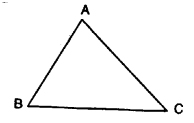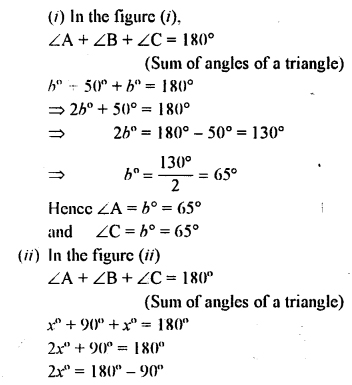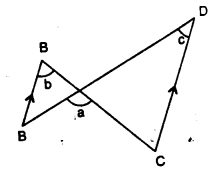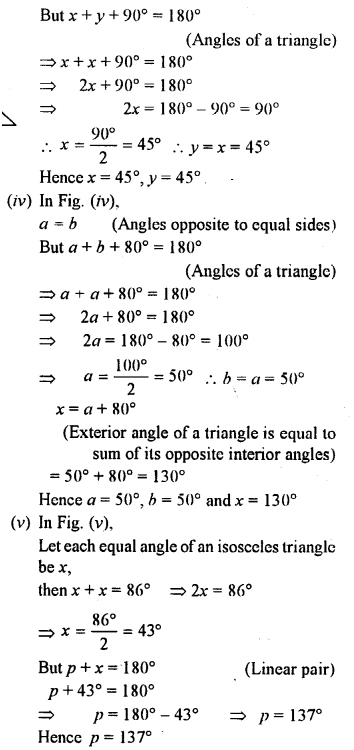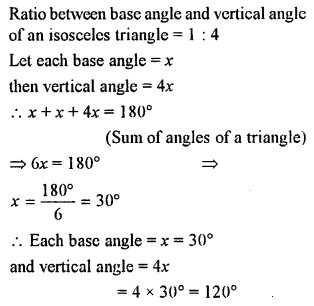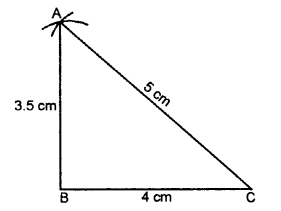Selina Concise Mathematics class 7 ICSE Solutions – Triangles
Selina Concise Mathematics Class 7 ICSE Solutions Chapter 15 Triangles
Selina Publishers Concise Maths Class 7 ICSE Solutions Chapter 15 TrianglesPOINTS TO REMEMBER
1. Definition of a triangle : A closed figure, having 3 sides, is called a triangle and is usually denoted by the Greek letter ∆ (delta).
The figure, given alongside, shows a triangle ABC (∆ABC) bounded by three sides AB, BC and CA.
Hence it has six elements : 3 angles and 3 sides.
Clearly, the given triangle has three vertices; namely : A, B and C. [Vertices is the plural of vertex]
3. Interior angles : In ∆ABC (given above), the angles BAC, ABC and ACB are called its interior angles as they lie inside the ∆ ABC. The sum of interior angles of a triangle is always 180°.
4. Exterior angles : When any side of a triangle is produced the angle so formed, outside the triangle and at its vertex, is called its exterior angle.
e.g. if side BC is produced to the point D; then ∠ACD is its exterior angle. And, if side AC is produced to the point E, then the exterior angle would be ∠BCE.
Thus. at every vertex, two exterior angles can be formed and that these two angles being vertically opposite angles, are always equal.
Make the following figures clear :
5. Interior opposite angles : When any side of a triangle is produced; an exterior angle is formed. The two interior angles of this triangle, that are opposite to the exterior angle formed; are called its interior opposite angles.
In the given figure, side BC of ∆ABC is produced to the point D, so that the exterior ∠ACD is formed.
Then the two interior opposite angles are ∠B AC and ∠ABC.
6. Relation between exterior angle and interior opposite angles :
Exterior angle of a triangle is always equal to thesum of its two interior opposite angles.
In ∆ABC,
Ext. ∠ACD = ∠A + ∠B
7. CLASSIFICATION OF TRIANGLES
(A) With regard to their angles :
1. Acute angled triangle : It is a triangle, whose each angle is acute i.c. each angle is less than 90°.
2. Right angled triangle : It is a triangle, whose one angle is a right angle i.e. equal to 90”.
The figure, given alongside, shows a right angled triangle XYZ as ∠XYZ = 90°
Note : (i) One angle of a right triangle is 90° and the other two angles of it are acute; such that their sum is always 90”.
In ∆XYZ, given above, ∠Y = 90° and each of ∠X and ∠Z is acute such that ∠X + ∠Z = 90°. .(ii)In a right triangle, the side opposite to the right angle is largest of all its sides and is called the hypotenuse. In given right angled ∆ XYZ side XZ is its hypotenuse
obtuse, it is called an obtuse angled triangle.
Note : In case of an obtuse angled triangle, each of the other two angles is always acute and their sum is less than 90”.
(B) With regard to their sides :(1) Scalene triangle: If all the sides of a triangle are unequal, it is called a scalene triangle.
In a scalene triangle; all its angles are also unequal.
(2) Isosceles triangle : If atleast two sides of a triangle are equal, it is called an isosceles triangle.
In ∆ ABC, shown alongside, side AB = side AC.
∴∆ ABC is an isosceles triangle.Note : (i) The angle contained by equal sides i.e. ∠BAC is called the vertical angle or the angle of vertex.
(ii) The third side (i.e. the unequal side) is called the base of the isosceles triangle.
(iii) The two other angles (i.e. other than the angle of vertex) are called the base angles of the triangle.
IMPORTANT PROPERTIES OF AN ISOSCELES TRIANGLE
The base angles i.e. the angles opposite to equal sides of an isosceles triangle are always equal.
In given triangle ABC,
(i) If side AB = side BC; then angle opposite to AB = angle opposite to BC i.e. ∠C = ∠A.
(ii) If side BC = side AC; then angle opposite to BC = angle opposite to AC i.e. ∠A = ∠B and so on.
Conversely : If any two angles of a triangle are equal; the sides opposite to these angles are also equal i.e. the triangle is isosceles.
Thus in ∆ ABC,
(i) If ∠B = ∠C => side opposite to ∠B = side opposite to ∠C i.e. side AC = side AB.
(ii) If ∠A = ∠B => side BC = side AC and so on.
If all the sides of a triangle are equal, it is called an equilateral triangle.
In the given figure, A ABC is equilateral, because AB = BC = CA.
Also, all the angles of an equilateral triangle are equal to each other and so each angle = 60°. [∵60° + 60° + 60° = 180°]
Since, all the angles of an equilateral triangle are equal, it is also known as equiangular triangle. Note : An equilateral triangle is always an isosceles triangle, but its converse is not always true.
(4) Isosceles right angled triangle : If one angle of an isosceles triangle is 90°, it is called an isosceles right angled triangle.
In the given figure, ∆ ABC is an isosceles right angled triangle, because : ∠ ACB = 90° and AC = BC.
Here, the base is AB, the vertex is C and the base angles are ∠BAC and ∠ABC, which are equal.
Since, the sura of the angles of a triangle = 180″
∴∠ABC = ∠BAC = 45 [∵45° + 45° + 90° = 180°]Triangles Exercise 15A – Selina Concise Mathematics Class 7 ICSE Solutions
Stale, if the triangles are possible with the following angles :
(i) 20°, 70° and 90°
(ii) 40°, 130° and 20°
(iii) 60°, 60° and 50°
(iv) 125°, 40° and 15°
Solution:
Question 2.
If the angles of a triangle are equal, find its angles.
Solution:
In a triangle ABC, ∠A = 45° and ∠B = 75°, find ∠C.
Solution:
In a triangle PQR, ∠P = 60° and ∠Q = ∠R, find ∠R.
Solution:
Calculate the unknown marked angles in each figure :
Solution:
Find the value of each angle in the given figures:
Solution:

Question 7.
Find the unknown marked angles in the given figure:
Solution:
Question 8.
In the given figure, show that: ∠a = ∠b + ∠c
(i) If ∠b = 60° and ∠c = 50° ; find ∠a.
(ii) If ∠a = 100° and ∠b = 55° : find ∠c.
(iii) If ∠a = 108° and ∠c = 48° ; find ∠b.
Solution:
Solution:
Question 10.
One angle of a triangle is 60°. The, other two angles are in the ratio of 5 : 7. Find the two angles.
Solution:
Question 11.
One angle of a triangle is 61° and the other two angles are in the ratio : 1
: 1 . Find these angles.
. Find these angles.
Solution:
Question 12.
Find the unknown marked angles in the given figures :
Solution:
Question 1.
Find the unknown angles in the given figures:
Solution:
Question 2.
Apply the properties of isosceles and equilateral triangles to find the unknown angles in the given figures :
Solution:
Question 3.
The angle of vertex of an isosceles triangle is 100°. Find its base angles.
Solution:
Question 4.
One of the base angles of an isosceles triangle is 52°. Find its angle of vertex.
Solution:
Question 5.
In an isosceles triangle, each base angle is four times of its vertical angle. Find all the angles of the triangle.
Solution:
Question 6.
The vertical angle of an isosceles triangle is 15° more than each of its base angles. Find each angle of the triangle.
Solution:
Question 7.
The base angle of an isosceles triangle is 15° more than its vertical angle. Find its each angle.
Solution:
Question 8.
The vertical angle of an isosceles triangle is three times the sum of its base angles. Find each angle.
Solution:
Question 9.
The ratio between a base angle and the vertical angle of an isosceles triangle is 1 : 4. Find each angle of the triangle.
Solution:
Question 10.
In the given figure, BI is the bisector of∠ABC and Cl is the bisector of ∠ACB. Find ∠BIC.
Solution:
Find the unknown marked angles in the given figure:
Solution:
In the given figure, show that: ∠a = ∠b + ∠c
(i) If ∠b = 60° and ∠c = 50° ; find ∠a.
(ii) If ∠a = 100° and ∠b = 55° : find ∠c.
(iii) If ∠a = 108° and ∠c = 48° ; find ∠b.
Solution:
Question 9.
Calculate the angles of a triangle if they are in the ratio 4 : 5 : 6.Solution:
One angle of a triangle is 60°. The, other two angles are in the ratio of 5 : 7. Find the two angles.
Solution:
One angle of a triangle is 61° and the other two angles are in the ratio
 : 1
: 1 . Find these angles.
. Find these angles.Solution:
Find the unknown marked angles in the given figures :
Solution:
Triangles Exercise 15B – Selina Concise Mathematics Class 7 ICSE Solutions
Find the unknown angles in the given figures:
Solution:
Apply the properties of isosceles and equilateral triangles to find the unknown angles in the given figures :
Solution:
The angle of vertex of an isosceles triangle is 100°. Find its base angles.
Solution:
One of the base angles of an isosceles triangle is 52°. Find its angle of vertex.
Solution:
In an isosceles triangle, each base angle is four times of its vertical angle. Find all the angles of the triangle.
Solution:
The vertical angle of an isosceles triangle is 15° more than each of its base angles. Find each angle of the triangle.
Solution:
The base angle of an isosceles triangle is 15° more than its vertical angle. Find its each angle.
Solution:
The vertical angle of an isosceles triangle is three times the sum of its base angles. Find each angle.
Solution:
The ratio between a base angle and the vertical angle of an isosceles triangle is 1 : 4. Find each angle of the triangle.
Solution:
In the given figure, BI is the bisector of∠ABC and Cl is the bisector of ∠ACB. Find ∠BIC.
Solution:
Question 11.
In the given figure, express a in terms of b.
Solution:
Question 12.
(a) In Figure (i) BP bisects ∠ABC and AB = AC. Find x.
(b) Find x in Figure (ii) Given: DA = DB = DC, BD bisects ∠ABC and∠ADB = 70°.
Solution:
(a) In Figure (i) BP bisects ∠ABC and AB = AC. Find x.
(b) Find x in Figure (ii) Given: DA = DB = DC, BD bisects ∠ABC and∠ADB = 70°.
Solution:
Question 13.
In each figure, given below, ABCD is a square and ∆ BEC is an equilateral triangle.
Find, in each case : (i) ∠ABE(ii) ∠BAE
Solution:
Question 14.
In ∆ ABC, BA and BC are produced. Find the angles a and h. if AB = BC.
Solution:
Question 1.
Construct a ∆ABC such that:
(i) AB = 6 cm, BC = 4 cm and CA = 5.5 cm
(ii) CB = 6.5 cm, CA = 4.2 cm and BA = 51 cm
(iii) BC = 4 cm, AC = 5 cm and AB = 3.5 cm
Solution:
(i) Steps of Construction :
(i) Draw a line segment BC = 4 cm.
(ii) With centre B and radius 6 cm draw an arc.
(iii) With centre C and radius 5.5 cm, draw another arc intersecting the First are at A.
(iv) Join AB and AC. ∆ABC is the required triangle.
(ii) Steps of Construction :
(i) Draw a line segment CB = 6 5 cm
(ii) With centre C and radius 4.2 cm draw an arc.
(iii) With centre B and radius 5.1 cm draw another arc intersecting the first arc at A.
(iv) Join AC and AB.
∆ ABC is the required triangle.
(iii) Steps of Construction :
(i) Draw a line segment BC = 4 cm.
(ii) With centre B and radius 3.5 cm, draw an arc
(iii) With centre C and radius 5 cm, draw another arc which intersects the first arc at A.
(iv) Join AB and AC.
∆ ABC is the required triangle.
Question 2.
Construct a A ABC such that:
(i) AB = 7 cm, BC = 5 cm and ∠ABC = 60°
(ii) BC = 6 cm, AC = 5.7 cm and ∠ACB = 75°
(iii) AB = 6.5 cm, AC = 5.8 cm and ∠A = 45°
Solution:
(i) Steps of Construction :
(i) Draw a line segment AB = 7 cm.
∆ABC is the required triangle.
(ii) Steps of Construction :
(i) Draw a line segment BC = 6 cm.
(ii) At C, draw a ray making an angle of 75° and cut off CA = 5.7 cm.
(iii) JoinAB
∆ ABC is the required triangle.
(iii) Steps of Construction :
(i) Draw a line segment AB = 6.5 cm
(ii) At A, draw a ray making an angle of 45° and cut off AC = 5.8 cm
(iii) JoinCB.
∆ ABC is the required triangle.
Question 3.
Construct a ∆ PQR such that :
(i) PQ = 6 cm, ∠Q = 60° and ∠P = 45°. Measure ∠R.
(ii) QR = 4.4 cm, ∠R = 30° and ∠Q = 75°. Measure PQ and PR.
(iii) PR = 5.8 cm, ∠P = 60° and ∠R = 45°.
Measure ∠Q and verify it by calculations
Solution:
(i) Steps of Construction:
(i) Draw a line segment PQ = 6 cm.
(ii) At P, draw a ray making an angle of 45°
(iii) At Q, draw another ray making an angle of 60° which intersects the first ray at R.
∆ PQR is the required triangle.
On measuring ∠R, it is 75°.
(ii) Steps of Construction :
(i) Draw a line segment QR = 44 cm.
(ii) At Q, draw a ray making an angle of 75°
(iii) At R, draw another arc making an angle of 30° ; which intersects the first ray at R
∆ PQR is the required triangle.
On measuring the lengths of PQ and PR, PQ = 2.1 cm and PR = 4. 4 cm.
(iii) Steps of Construction :
(i) Draw a line segment PR = 5.8 cm
(ii) At P, construct an angle of 60°
(iii) At R, draw another angle of 45° meeting each other at Q.
∆ PQR is the required triangle. On measuring ∠Q, it is 75°
Verification : We know that sum of angles of a triangle is 180°
∴∠P + ∠Q + ∠R = 180°
⇒ 60° + ∠Q + 45° = 180°
⇒ ∠Q + 105° = 180°
⇒ ∠Q = 180° – 105° = 75°.
Question 4.
Construct an isosceles A ABC such that:
(i) base BC = 4 cm and base angle = 30°
(ii) base AB = 6-2 cm and base angle = 45°
(iii) base AC = 5 cm and base angle = 75°.
Measure the other two sides of the triangle.
Solution:
(i) Steps of Construction :
We know that in an isosceles triangle base angles are equal.
(i) Draw a line segment BC = 4 cm.
(ii) Steps of Construction :
We know that in an isosceles triangle, base angles are equal.
(i) Draw a line segment AB = 6.2 cm
(iii) Steps of Construction :
We know that base angles of an isosceles triangles are equal.
(i) Draw a line segment AC = 5cm.
Question 5.
Construct an isosceles ∆ABC such that:
(i) AB = AC = 6.5 cm and ∠A = 60°
(ii) One of the equal sides = 6 cm and vertex angle = 45°. Measure the base angles.
(iii) BC = AB = 5-8 cm and ZB = 30°. Measure ∠A and ∠C.
Solution:
(i) Steps of Construction :
(i) Draw a line segment AB = 6.5 cm.
(ii) At A, draw a ray making an angle of 60°.
(iii) Cut off AC = 6.5 cm
(iv) JoinBC.
∆ABC is the required triangle.
(ii) Steps of Construction :
(i) Draw a line segment AB = 6 cm
(ii) At A, construct an angle equal to 45°
(iii) Cut off AC = 6 cm
(iv) JoinBC.
∆ ABC is the required triangle.
On measuring, ∠B and ∠C, each is equal 1° to, 67 °
°
(iii) Steps of Construction :
(i) Draw a line segment BC = 5.8 cm
(i) AB = 5 cm. Draw the perpendicular bisectors of BC and AC. Let P be the point of intersection of these two bisectors. Measure PA, PB and PC.
(ii) Each side is 6 cm.
Solution:
(i) Steps of Construction :
(i) Draw a line segment AB = 5 cm.
(ii) With centres A and B and radius 5 cm each, draw two arcs intersecting each other at C.
(iii) Join AC and BC ∆ABC is the required triangle.
(iv) Draw the perpendicular bisectors of sides AC and BC which intersect each other at P-
(v) Join PA, PB and PC.
On measuring, each is 2.8 cm.
(ii) Steps of Construction :
(i) Draw a line segment AB = 6 cm.
(ii) At A and B as centre and 6 cm as radius draw two arcs intersecting each other at C.
(iii) Join AC and BC.
∆ABC is the required triangle.
Question 7.
(i) Construct a ∆ ABC such that AB = 6 cm, BC = 4.5 cm and AC = 5.5 cm. Construct a circumcircle of this triangle.
(ii) Construct an isosceles ∆PQR such that PQ = PR = 6.5 cm and ∠PQR = 75°. Using ruler and compasses only construct a circumcircle to this triangle.
(iii) Construct an equilateral triangle ABC such that its one side = 5.5 cm.
Construct a circumcircle to this triangle.
Solution:
Question 8.
(i) Construct a ∆ABC such that AB = 6 cm, BC = 5.6 cm and CA = 6.5 cm. Inscribe a circle to this triangle and measure its radius.
(ii) Construct an isosceles ∆ MNP such that base MN = 5.8 cm, base angle MNP = 30°. Construct an incircle to this triangle and measure its radius.
(iii) Construct an equilateral ∆DEF whose one side is 5.5 cm. Construct an incircle to this triangle.
(iv) Construct a ∆ PQR such that PQ = 6 cm, ∠QPR = 45° and angle PQR = 60°. Locate its incentre and then draw its incircle.
Solution:
In each figure, given below, ABCD is a square and ∆ BEC is an equilateral triangle.
Find, in each case : (i) ∠ABE(ii) ∠BAE
Solution:
In ∆ ABC, BA and BC are produced. Find the angles a and h. if AB = BC.
Solution:
Triangles Exercise 15C – Selina Concise Mathematics Class 7 ICSE Solutions
Construct a ∆ABC such that:
(i) AB = 6 cm, BC = 4 cm and CA = 5.5 cm
(ii) CB = 6.5 cm, CA = 4.2 cm and BA = 51 cm
(iii) BC = 4 cm, AC = 5 cm and AB = 3.5 cm
Solution:
(i) Steps of Construction :
(i) Draw a line segment BC = 4 cm.
(ii) With centre B and radius 6 cm draw an arc.
(iii) With centre C and radius 5.5 cm, draw another arc intersecting the First are at A.
(iv) Join AB and AC. ∆ABC is the required triangle.
(ii) Steps of Construction :
(i) Draw a line segment CB = 6 5 cm
(ii) With centre C and radius 4.2 cm draw an arc.
(iii) With centre B and radius 5.1 cm draw another arc intersecting the first arc at A.
(iv) Join AC and AB.
∆ ABC is the required triangle.
(iii) Steps of Construction :
(i) Draw a line segment BC = 4 cm.
(ii) With centre B and radius 3.5 cm, draw an arc
(iii) With centre C and radius 5 cm, draw another arc which intersects the first arc at A.
(iv) Join AB and AC.
∆ ABC is the required triangle.
Question 2.
Construct a A ABC such that:
(i) AB = 7 cm, BC = 5 cm and ∠ABC = 60°
(ii) BC = 6 cm, AC = 5.7 cm and ∠ACB = 75°
(iii) AB = 6.5 cm, AC = 5.8 cm and ∠A = 45°
Solution:
(i) Steps of Construction :
(i) Draw a line segment AB = 7 cm.
(ii) At B, draw a ray making an angle of 60° and cut off BC = 5 cm
(iii) Join AC,∆ABC is the required triangle.
(ii) Steps of Construction :
(i) Draw a line segment BC = 6 cm.
(ii) At C, draw a ray making an angle of 75° and cut off CA = 5.7 cm.
(iii) JoinAB
∆ ABC is the required triangle.
(iii) Steps of Construction :
(i) Draw a line segment AB = 6.5 cm
(ii) At A, draw a ray making an angle of 45° and cut off AC = 5.8 cm
(iii) JoinCB.
∆ ABC is the required triangle.
Question 3.
Construct a ∆ PQR such that :
(i) PQ = 6 cm, ∠Q = 60° and ∠P = 45°. Measure ∠R.
(ii) QR = 4.4 cm, ∠R = 30° and ∠Q = 75°. Measure PQ and PR.
(iii) PR = 5.8 cm, ∠P = 60° and ∠R = 45°.
Measure ∠Q and verify it by calculations
Solution:
(i) Steps of Construction:
(i) Draw a line segment PQ = 6 cm.
(ii) At P, draw a ray making an angle of 45°
(iii) At Q, draw another ray making an angle of 60° which intersects the first ray at R.
∆ PQR is the required triangle.
On measuring ∠R, it is 75°.
(ii) Steps of Construction :
(i) Draw a line segment QR = 44 cm.
(ii) At Q, draw a ray making an angle of 75°
(iii) At R, draw another arc making an angle of 30° ; which intersects the first ray at R
∆ PQR is the required triangle.
On measuring the lengths of PQ and PR, PQ = 2.1 cm and PR = 4. 4 cm.
(iii) Steps of Construction :
(i) Draw a line segment PR = 5.8 cm
(ii) At P, construct an angle of 60°
(iii) At R, draw another angle of 45° meeting each other at Q.
∆ PQR is the required triangle. On measuring ∠Q, it is 75°
Verification : We know that sum of angles of a triangle is 180°
∴∠P + ∠Q + ∠R = 180°
⇒ 60° + ∠Q + 45° = 180°
⇒ ∠Q + 105° = 180°
⇒ ∠Q = 180° – 105° = 75°.
Question 4.
Construct an isosceles A ABC such that:
(i) base BC = 4 cm and base angle = 30°
(ii) base AB = 6-2 cm and base angle = 45°
(iii) base AC = 5 cm and base angle = 75°.
Measure the other two sides of the triangle.
Solution:
(i) Steps of Construction :
We know that in an isosceles triangle base angles are equal.
(i) Draw a line segment BC = 4 cm.
(ii) At B and C, draw rays making an angle of 30° each intersecting each other at A.
∆ ABC is the required triangle.
On measuring the equal sides each is 2.5 cm (approx.) in length.(ii) Steps of Construction :
We know that in an isosceles triangle, base angles are equal.
(i) Draw a line segment AB = 6.2 cm
(ii) At A and B, draw rays making an angle of 45° each which intersect each other at C.
∆ABC is the required triangle.
On measuring the equal sides, each is 4.3 cm (approx.) in length.(iii) Steps of Construction :
We know that base angles of an isosceles triangles are equal.
(i) Draw a line segment AC = 5cm.
(ii) At A and C, draw rays making an angle of 75° each which intersect each other at B.
∆ ABC is the required triangle.
On measuring the equal sides, each is 9.3 cm in length.Question 5.
Construct an isosceles ∆ABC such that:
(i) AB = AC = 6.5 cm and ∠A = 60°
(ii) One of the equal sides = 6 cm and vertex angle = 45°. Measure the base angles.
(iii) BC = AB = 5-8 cm and ZB = 30°. Measure ∠A and ∠C.
Solution:
(i) Steps of Construction :
(i) Draw a line segment AB = 6.5 cm.
(ii) At A, draw a ray making an angle of 60°.
(iii) Cut off AC = 6.5 cm
(iv) JoinBC.
∆ABC is the required triangle.
(ii) Steps of Construction :
(i) Draw a line segment AB = 6 cm
(ii) At A, construct an angle equal to 45°
(iii) Cut off AC = 6 cm
(iv) JoinBC.
∆ ABC is the required triangle.
On measuring, ∠B and ∠C, each is equal 1° to, 67
 °
°(iii) Steps of Construction :
(i) Draw a line segment BC = 5.8 cm
(ii) At B, draw a ray making an angle of 30°.
(iii) Cut off BA = 5.8 cm
(iv) Join AC.∆ ABC is the required triangle On measuring ∠C and ∠A, each is equal to 75°.
Question 6.
Construct an equilateral A ABC such that:(i) AB = 5 cm. Draw the perpendicular bisectors of BC and AC. Let P be the point of intersection of these two bisectors. Measure PA, PB and PC.
(ii) Each side is 6 cm.
Solution:
(i) Steps of Construction :
(i) Draw a line segment AB = 5 cm.
(ii) With centres A and B and radius 5 cm each, draw two arcs intersecting each other at C.
(iii) Join AC and BC ∆ABC is the required triangle.
(iv) Draw the perpendicular bisectors of sides AC and BC which intersect each other at P-
(v) Join PA, PB and PC.
On measuring, each is 2.8 cm.
(ii) Steps of Construction :
(i) Draw a line segment AB = 6 cm.
(ii) At A and B as centre and 6 cm as radius draw two arcs intersecting each other at C.
(iii) Join AC and BC.
∆ABC is the required triangle.
Question 7.
(i) Construct a ∆ ABC such that AB = 6 cm, BC = 4.5 cm and AC = 5.5 cm. Construct a circumcircle of this triangle.
(ii) Construct an isosceles ∆PQR such that PQ = PR = 6.5 cm and ∠PQR = 75°. Using ruler and compasses only construct a circumcircle to this triangle.
(iii) Construct an equilateral triangle ABC such that its one side = 5.5 cm.
Construct a circumcircle to this triangle.
Solution:
(i) Construct a ∆ABC such that AB = 6 cm, BC = 5.6 cm and CA = 6.5 cm. Inscribe a circle to this triangle and measure its radius.
(ii) Construct an isosceles ∆ MNP such that base MN = 5.8 cm, base angle MNP = 30°. Construct an incircle to this triangle and measure its radius.
(iii) Construct an equilateral ∆DEF whose one side is 5.5 cm. Construct an incircle to this triangle.
(iv) Construct a ∆ PQR such that PQ = 6 cm, ∠QPR = 45° and angle PQR = 60°. Locate its incentre and then draw its incircle.
Solution:










